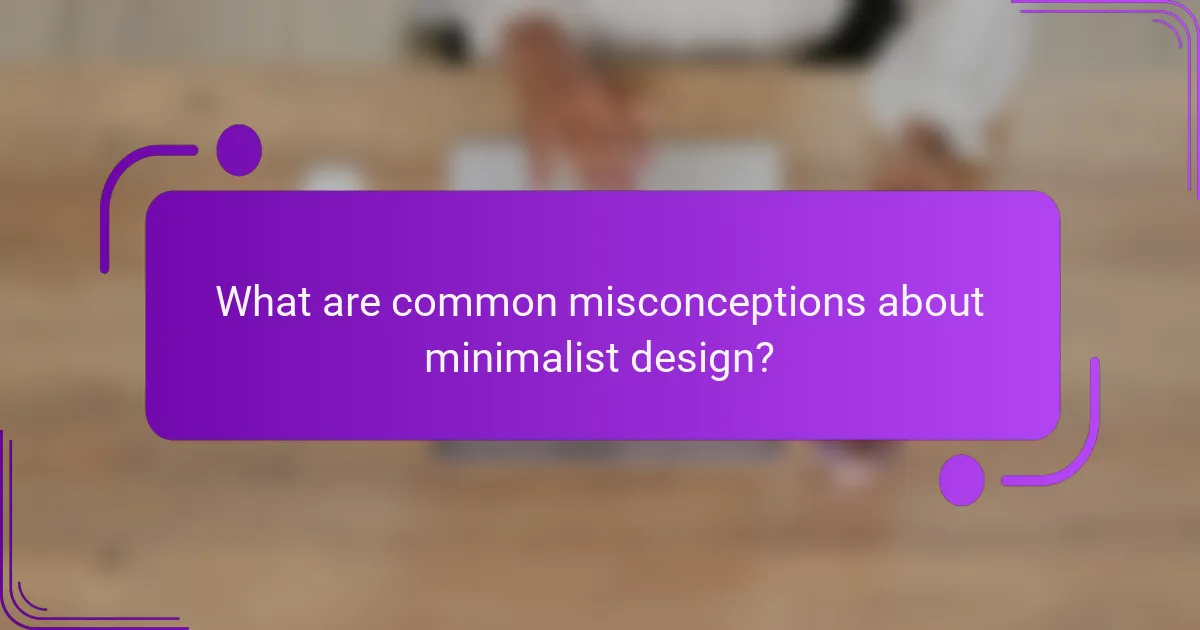Minimalist design is a powerful approach that enhances user experience by prioritizing simplicity and functionality. By stripping away unnecessary elements, it creates clean interfaces that allow for intuitive navigation and efficient interactions. This design philosophy not only emphasizes aesthetic appeal through the use of negative space and limited color palettes but also ensures that essential features remain at the forefront, making it easier for users to engage with products and services.

How does minimalist design enhance user experience?
Minimalist design enhances user experience by simplifying interfaces and removing unnecessary elements, allowing users to navigate more intuitively. This approach prioritizes essential features, making interactions smoother and more efficient.
Improved navigation
Minimalist design improves navigation by presenting clear pathways for users to follow. With fewer distractions, users can quickly identify key actions, such as buttons or links, leading to a more straightforward journey through the site or application.
For example, a website with a clean layout and a limited number of menu items allows users to find what they need without sifting through clutter. This streamlined navigation can significantly reduce the time spent searching for information.
Reduced cognitive load
By eliminating unnecessary elements, minimalist design reduces cognitive load, allowing users to focus on the task at hand. When a design presents only essential information, users can process content more efficiently without feeling overwhelmed.
Consider a mobile app that uses a simple interface with clear icons and labels. Users can quickly understand how to interact with the app, leading to faster decision-making and a more enjoyable experience.
Increased focus on content
Minimalist design directs users’ attention to the content that matters most. By using ample white space and limiting visual distractions, users can engage more deeply with the information presented.
For instance, a blog that employs a minimalist layout allows readers to concentrate on the text and images without being sidetracked by excessive advertisements or decorative elements. This focus can enhance comprehension and retention of the material.

What are the key principles of minimalist design?
Minimalist design focuses on simplicity and functionality by stripping away unnecessary elements to enhance aesthetic appeal and user experience. The key principles include the use of negative space, a limited color palette, and simple typography, all aimed at creating a clean and efficient interface.
Use of negative space
Negative space, or white space, refers to the empty areas around design elements. This principle helps to create a sense of balance and clarity, allowing users to focus on the essential components of a design without distraction. Effective use of negative space can improve readability and make navigation more intuitive.
When implementing negative space, consider leaving ample margins and spacing between elements. A common guideline is to maintain at least 20% of the design area as negative space to ensure a clean look. Avoid cluttering the interface, as this can overwhelm users and detract from the overall experience.
Limited color palette
A limited color palette involves using a small selection of colors to create a cohesive and harmonious design. This approach not only enhances visual appeal but also simplifies decision-making for users, making it easier to navigate and interact with the content. Typically, a minimalist design may use two to four primary colors.
When selecting colors, consider using neutral tones as a base, complemented by one or two accent colors for emphasis. This strategy can help maintain a clean aesthetic while guiding users’ attention to key areas. Avoid overly bright or contrasting colors that can create visual noise and disrupt the user experience.
Simple typography
Simple typography focuses on using clean, legible fonts that enhance readability and align with the minimalist aesthetic. Choosing one or two typefaces can help maintain consistency and clarity throughout the design. Sans-serif fonts are often preferred in minimalist designs for their modern and straightforward appearance.
When selecting typography, prioritize font sizes and weights that create a clear hierarchy of information. A common practice is to use larger sizes for headings and smaller sizes for body text, ensuring that users can easily distinguish between different types of content. Avoid decorative fonts that can detract from the minimalist approach and confuse users.

How can businesses implement minimalist design?
Businesses can implement minimalist design by focusing on essential elements that enhance user experience while eliminating unnecessary clutter. This approach emphasizes simplicity, functionality, and aesthetic appeal, ensuring that users can navigate and interact with products or services effortlessly.
Website redesign examples
When redesigning a website with a minimalist approach, consider using ample white space, a limited color palette, and straightforward navigation. For instance, brands like Apple and Google exemplify minimalist design by prioritizing product images and concise text, allowing users to focus on key information without distractions.
To effectively implement this, businesses should conduct user testing to identify which elements are essential for their audience. Avoid overwhelming users with too many options or information, as this can lead to decision fatigue.
Mobile app interfaces
Minimalist design in mobile app interfaces enhances usability by streamlining features and focusing on core functionalities. Apps like Instagram and Spotify utilize simple layouts and intuitive icons, making it easy for users to navigate and engage with content quickly.
When designing an app, prioritize essential features and consider using gestures for navigation to reduce on-screen clutter. Regularly update the interface based on user feedback to maintain a clean and efficient experience.
Product packaging
For product packaging, minimalist design can create a strong brand identity while appealing to environmentally conscious consumers. Brands like Muji and Coca-Cola often use simple designs with clear labeling and minimal graphics, which convey quality and sophistication.
To achieve effective minimalist packaging, focus on sustainable materials and clear messaging. Ensure that the design reflects the brand’s values and resonates with the target audience, while avoiding excessive embellishments that may detract from the product itself.

What are the benefits of minimalist design for brands?
Minimalist design offers brands a streamlined approach that enhances clarity and focus, making it easier for consumers to connect with their message. By reducing clutter, brands can create a more memorable and impactful identity that resonates with their audience.
Enhanced brand recognition
Minimalist design helps brands stand out by simplifying their visual identity, making logos and messaging more recognizable. A clean and straightforward aesthetic allows consumers to easily recall the brand, leading to stronger associations and loyalty.
For example, companies like Apple and Nike utilize minimalist design to create iconic logos that are instantly identifiable. This approach can significantly improve brand recall, especially in crowded markets.
Increased customer engagement
By focusing on essential elements, minimalist design encourages users to interact with content without distractions. This clarity can lead to longer time spent on websites or apps, as users find it easier to navigate and engage with the material presented.
Brands can enhance engagement by using simple layouts, ample white space, and clear calls to action. Ensuring that the user experience is intuitive can lead to higher satisfaction and repeat visits.
Higher conversion rates
Minimalist design can lead to higher conversion rates by reducing friction in the user journey. When users encounter a straightforward and visually appealing interface, they are more likely to complete desired actions, such as making a purchase or signing up for a newsletter.
To maximize conversions, brands should focus on essential features and eliminate unnecessary elements that could confuse or overwhelm users. A/B testing different minimalist designs can help identify the most effective layout for driving conversions.

What are common misconceptions about minimalist design?
Common misconceptions about minimalist design include the belief that it lacks creativity and is limited to specific industries. In reality, minimalist design can be both innovative and applicable across various fields, enhancing aesthetic appeal, user experience, and functionality.
Minimalism equals lack of creativity
One prevalent myth is that minimalist design stifles creativity. However, minimalism often requires a high level of creativity to communicate ideas effectively with fewer elements. Designers must think critically about each component’s purpose and how it contributes to the overall message.
For example, a minimalist website may use ample white space and simple typography, yet it can still convey a strong brand identity. The challenge lies in making thoughtful choices that enhance the user experience while maintaining a clean look.
Minimalism is only for tech companies
Another misconception is that minimalist design is exclusive to tech companies. While many tech brands adopt minimalism to emphasize functionality and usability, this design approach is versatile and can be found in various sectors, including fashion, interior design, and product packaging.
Businesses in any industry can benefit from minimalist principles by focusing on essential features and eliminating clutter. For instance, a minimalist restaurant might use a simple menu design that highlights key dishes, making it easier for customers to make choices without overwhelming them.

How does minimalist design impact functionality?
Minimalist design enhances functionality by prioritizing essential elements, reducing clutter, and improving user focus. This approach leads to more intuitive interactions and streamlined experiences, allowing users to achieve their goals efficiently.
Streamlined user interactions
Minimalist design simplifies user interactions by eliminating unnecessary elements, which helps users navigate interfaces more easily. For instance, a clean layout with clear calls to action can guide users towards completing tasks without distraction. This can be particularly beneficial in applications where quick decision-making is crucial, such as e-commerce sites.
To achieve streamlined interactions, prioritize key functionalities and ensure that navigation is intuitive. Avoid overloading pages with excessive information or features that may confuse users. A good rule of thumb is to limit choices to a few options to enhance decision-making speed.
Faster loading times
Minimalist design can significantly improve loading times by reducing the number of elements that need to be loaded on a page. Fewer images, scripts, and stylesheets mean less data for users to download, resulting in quicker access to content. This is especially important for mobile users, where connection speeds can vary widely.
To optimize loading times, consider compressing images and using efficient coding practices. Aim for a loading time of under three seconds to minimize bounce rates. Regularly test your site’s performance using tools like Google PageSpeed Insights to identify areas for improvement.
